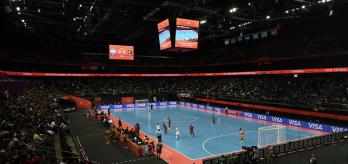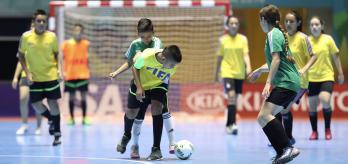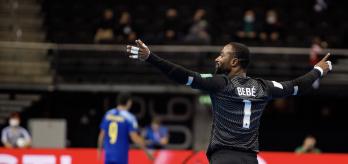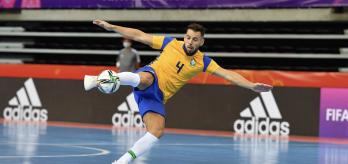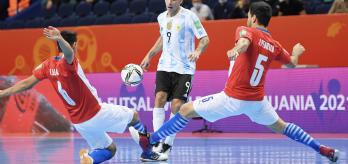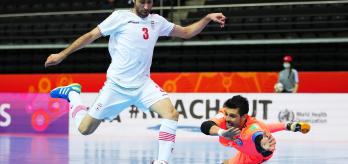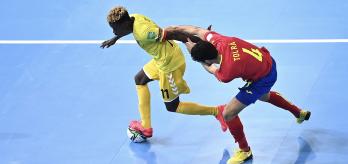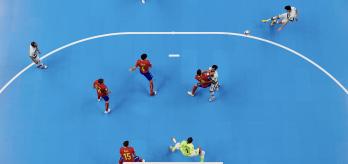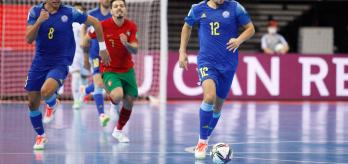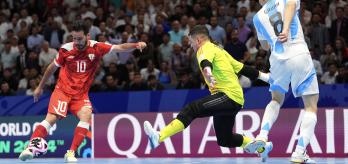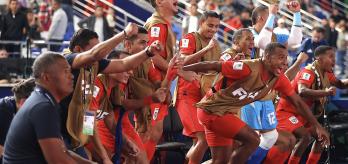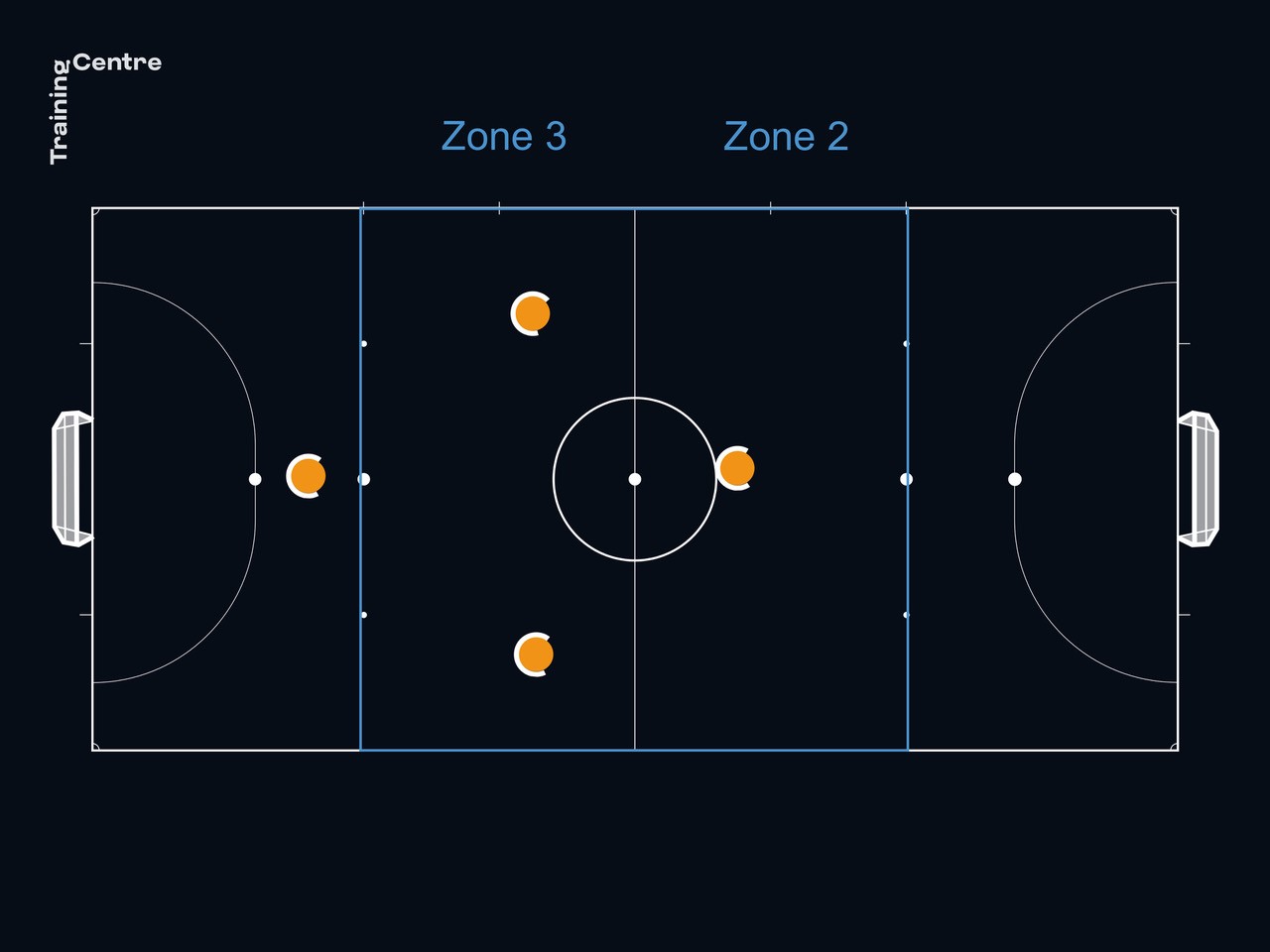
Teams like Lithuania, Venezuela, Vietnam and USA opted almost permanently for this defensive line.
Reasons for choosing the mid-block:
- As part of their philosophy or concept of play
- Based on the opposition
- Intentionally at different stages of a match (depending on the scoreline, tiredness, and the risk of giving away a DFKSAF, etc.)
Aims of the mid-block
One is to feel better protected, to compress the area to defend and to avoid spaces in behind. Another was to let the opposition play on the front foot and once they had made an error, hit them on the counter-attack when they were yet to reorganise.
In either of these cases, it is important to keep an active, aggressive defensive attitude so as to give the opposition no time to think. Otherwise, it would be counterproductive to defend only 20 metres from the goal.
Types of defensive approach with a mid-block
1. Passive approach
Waiting for the error; not proactive; no pressure on the ball. This kind of block was not seen much and was mostly used by teams with little futsal tradition, no professional league and little development.
2. Aggressive approach
Mid-block mid press. How does this work?
Types of mid-block marking
In the mid-block, there was not one type of marking which was any more or less effective, but it was whether it was well executed or not. At the World Cup, most teams employed man-to-man marking with defensive help and cover, and "passing on" opponents at the same time. Few teams went with pure zonal defending.
To sum up, there was a very clear profile of man-to-man marking along with "passing on" opponents in certain circumstances with very clear signals, such as when the ball was under fierce pressure, to help a team-mate who had lost his opponent, passing on opponents laterally or exchanges that were simple and easy to make.
Some examples:
- Individual defensive man-marking
- Mixed (man-to-man and changing opponent) depending on the situation
- Zonal defence employed by a few teams such as Lithuania
Mid-block and mid press in phases of play
In the defensive phase with high-block organisation, we could see the following specific moments:
- Kick-in in opposition zone 1.
- Kick-in/free kick in opposition zones 2-3, forcing the team to defend in a mid-block.
- Goalkeeper distribution following opposition shot: going to mid-block to defend or up to a high block when possible.
- Open play: on losing the ball, decision to stay organised in a mid-block without the option to move up to a high block, whether that be your usual defensive line or just at that moment of the match.
- Open play: the team are in the mid-block and carry out a mid press, but only clear the ball from their own half of the pitch. They do not get up into a high block or press, but drop back to a mid-block. Only Lithuania did this.
- Open play: the team are organised into a mid-block and then step up into a high block with the usual defensive line
- Open play → those teams that tried defending in a high block but could not and were forced by the opposition to defend in a mid-block, yet scarcely managed this and reverted to a high block.
- After an opposition goal attempt, the goalkeeper plays a long kick‑out which takes the team to the mid-block where they reorganise to either stay in place or step up to a high block.
- After a ball recovery, everyone behind the ball gets up into a mid-block.
Some tactical components of the mid-block
1. The opposite winger
This is a key aspect of defending in a mid-block, and almost all teams, except for the least tactically sophisticated, were careful with the opposite winger’s focus, with his physical placement (knowing where to look) and ability to keep the correct distance, both crucial to how their defence functioned. The opposite winger is vital to the support system and defensive cover in a modern mid-block defence.
2. Defensive jumps
Some of the most tactically sophisticated teams practised the "defensive jump" in this part of the pitch. This requires great coordination among the whole team. The objective is to surprise your opponent when they have the ball, and try to win it back. The risks are high if this is done without a clear defensive advantage.
3. Defending balls inside to the pivot
An important point with this mid-block defence is how to defend balls inside to the pivot. Teams attacking the mid-block with a 3-1 or 2-2 system tried, on numerous occasions, to finish the move with balls to the pivot. For the best teams, having a clear plan about how to defend dangerous situations of this kind was fundamental to their success. Examples of the solutions that teams found for this situation during the World Cup:
- Some teams opted to defend man to man, with a clear individual responsibility for the man marking the pivot, with no type of defensive help from team-mates. If the ball reached the pivot, each defender stayed with his attacker.
- Other teams found a solution by switching the opponents they were marking.
- Through anticipation, bearing in mind the risk that this could go wrong.
- Another important point for some teams was a 2v1 on the pivot, either on the wing or in the middle.
- Another situation requiring great coordination and risk is to seal off the pivot by getting bodies around him.
4. Providing cover
Another point was the kind of cover used for 1v1s. With this type of defence, it is vital to have a clear system for cover. The covering came primarily from the defender or from the goalkeeper. A couple of the approaches observed at the World Cup:
- Primary defensive cover
- Defender + opposite winger who goes into the defender’s position
To follow on from the previous situation of how to defend 1v1 in the mid-block, a lot of teams chose to defend 1v1s involving the best dribblers on the flank. This was done with a quick defensive switch from the original formation to a zonal 2-2 system. This is to try to avoid the player on the ball running straight through on goal if he gets the better of the player marking him. It requires a strong understanding between the players to quickly assign defensive roles – and, therefore, training of sufficient quality and quantity.



